JuergensSandbox
The new Karl G. Jansky Very Large Array (VLA) correlator is extremely powerful in its spectral capabilities. The final specifications include up to 4 million channels that can be distributed in up to 64 subbands with a spectral resolution from from 2MHz down to the the Hz regime. Here is a guide to access that spectral line power and we describe what is offered for the August 2012 deadline.
VLA Spectral Line Observing
This guide is to help understand and set up spectral line observations at the VLA. The new, wide bandwidths of the VLA allow users to observe up to 8GHz of spectral bandwidth at a time. Apart from extreme continuum sensitivity, the wide bands of the VLA can be used to observe multiple spectral lines simultaneously. Furthermore, the WIDAR correlator is extremely flexible and acts, fundamentally, like up to 64 independent correlators with different bandwidths, channel numbers, polarization products, and observing frequencies. The final VLA can
- deliver continuous spectral coverage up to a full width of 8GHz
- access 1GHz or 2GHz chunks in each receiver band (called basebands) and place correlator subbands on them; this enables observations of multiple spectral lines at once
- use up to 64 subbands at a time that are independently tunable, and can be configured in different spectral bandwidths, channel numbers, and number of polarization products
- derive the frequency from the velocity of a given spectral line (Doppler Setting)
- Dynamically schedule the observations to use the best weather conditions for high frequency, high scientific impact projects
For the August 1 deadline, the following capabilities are offered (more options are available for "shared risk" observing, see the VLA Observational Status Summary):
- two polarization pairs 1GHz each (using the 8-bit samplers)
- up to 16 subband polarization pairs per baseband polarization pair
- independent tuning of all subbands
- independent subband bandwidth in the 31.5-128MHz range
- independent number of channels, up to 2048 channels for single polarization product, 1024 dual, 512 full polarization; maximum number of channels distributed across all subbands and polarization products cannot exceed 16384 channels
- Doppler setting
- The maximum data rate, however, cannot exceed 15MB/s
- for the wideband 3-bit samplers, 2x2GHz baseband polarization pairs can be set up with 2MHz resolution
Line Rest Frequencies
There are a number of online tools available that help spectral line observers. The recommended line rest frequency catalog for VLA and ALMA is Splatalogue which contains data from the Lovas catalog, the JPL/NASA molecular database], the Cologne Database for Molecular Spectroscopy, as well as radio recombination lines and data from other resources.
Observing Frequency and Velocity Definitions
The first step is to determine the observing frequency of the spectral line. This is derived from the radial velocity of the source and the rest frequency of the spectral line.
A full relativistic calculation shows that the velocity is determined via and is called the relativistic velocity. The equation is a bit cumbersome to use and in astronomy two different approximations are typically used instead:
- Optical Velocity ( is the redshift of the source)
- Radio Velocity
The radio and optical velocities are not identical. At low velocities that difference is small but and diverge more and more for large values. Traditionally, the optical velocities are predominantly used for extragalactic and the radio velocities for Galactic targets.
At significant redshifts, it is advisable to place the zero point of the velocity frame into the source via
where the redshifted can now be used as the input rest frequency for the observations. The velocities that are derived based on such a redshifted rest frequency will be correctly scaled for the spread of the velocity scale that is caused by the redshift.
Velocity Frames
The earth rotates, revolves around the sun, rotates around the galaxy, moves within the Local Group, and shows motion against the cosmic microwave background. If one measures a velocity it is therefore necessary to correct for such motions and define the frame in which the velocities are measured.
There are various rest frames used in the literature. The following table lists their name, the motion that is corrected for, and the maximum amplitude of the velocity correction. Each rest frame correction is incremental to the preceding row:
| Rest Frame Name | Rest Frame | Correct for | Max amplitude [km/s] |
| Topocentric | Telescope | Nothing | 0 |
| Geocentric | Earth Center | Earth rotation | 0.5 |
| Earth-Moon Barycentric | Earth+Moon center of mass | Motion around Earth+Moon center of mass | 0.013 |
| Heliocentric | Center of the Sun | Earth orbital motion | 30 |
| Barycentric | Earth+Sun center of mass | Earth+Sun center of mass | 0.012 |
| Local Standard of Rest (LSR) | Center of Mass of local stars | Solar motion relative to nearby stars | 20 |
| Galactocentric | Center of Milky Way | Milky Way Rotation | 230 |
| Local Group Barycentric | Local Group center of mass | Milky Way Motion | 100 |
| Virgocentric | Center of the Local Virgo supercluster | Local Group motion | 300 |
| Cosmic Microwave Background | CMB | Local Supercluster Motion | 600 |
The velocity frame should be chosen based on the science. For most observations, however, one of the the following three reference frames is commonly used:
- Topocentric, the natural velocity frame of the observatory (defining the sky frequency of the observations). Visibilities in a measurement set are typically stored in this velocity frame.
- Local Standard of Rest: the native output of images in CASA. Note that there are two varieties of LSR: the kinematic LSR (LSRK) and the dynamic (LSRD) definitions for the kinematic and dynamic centers, respectively. In almost all cases LSRK is being used and the less precise LSR naming is usually used synonymously with more modern LSRK definition.
- Barycentric: a common frame that has virtually replaced the older heliocentric standard. Given the small difference between barycentric and heliocentric, they were frequently used interchangeably.
A full list of CASA supported reference frames is provided in the [CASA reference Manual and Cookbook] and also on the [casaguides.nrao.edu webpage]
Doppler Correction
A telescope frequently operates at a fixed sky frequency (Topocentric velocity frame). Any spectral line will thus shift during any observation campaign. Within a day, the rotation of the earth dominates and the line may shift up to 0.5km/s, depending on the position on the sky (see above). Observing campaigns that span over a year, may see spectral lines to shift in frequency by up to 30km/s due to the earth's motion around the sun.
Side note: As a rule of thumb, 1 MHz in frequency corresponds roughly to km/s for the line at a wavelength of in mm. E.g., at a wavelength of 7mm, 1MHz corresponds to about 7km/s in velocity, at 21cm 1MHz corresponds roughly to 210km/s.
Using this rule of thumb, a line may shift by up to 5MHz in Q-band and by up to 0.15MHz in L-band over the course of a year. This needs to be taken into account when setting up the observations. There are different ways to do this:
- use the same sky frequency for all observations. The shift of the line (maximum of 30km/s) is accommodated by a wide bandwidth that covers the line and its width at any time of the observation campaign. The data is later regridded in CASA to a common LSRK or BARY velocity frame. The sky frequency of an observation can be computed with the Dopset tool for a given time. One may find the LST dates for an observation on the VLA Schedule Page.
- calculate a fixed sky frequency at the beginning of an observation, then keep it fixed for the duration of the scheduling block. This is called Doppler Setting and offered by OPT (currently only in OSRO mode). The line shift is then minimized to the rotation of the earth (maximum amplitude 0.5km/s). This small shift is corrected by post processing.
- change the sky frequency continuously to keep the line at the same position in the band. This method is called Doppler tracking and was standard for the pre-upgrade VLA. The new VLA does NOT support Doppler tracking. The WIDAR correlator offers enough bandwidth and spectral channels to cover any line shift and post-processing regridding needs. In addition, a non-variable sky frequency may also deliver a more robust calibration and overall system stability.
The post-processing regridding of the line in CASA can be either done directly during imaging in the task clean, or alternatively with the task cvel. The regridding works well when the spectral features are sampled with at least 4 channels.
Gibbs Phenomenon and Hanning smoothing
For very sharp spectral or lag features, a Fourier transform can prominently display a sinc function, a channel by channel fluctuation of the amplitude. If this is apparent in the data, smoothing adjacent channels will reduce or even eliminate the effect. The smoothing kernel to be used is a Hanning smoothing function which sports a triangular kernel with the central channel being weighed by 0.5 and the two adjacent channels by 0.25. After Hanning smoothing, however, the channels are not independent anymore and one can eliminate every other channel without losing signal to noise.
In the VLA days, the correlator design (with a truncated lag spectrum) could show the Gibbs phenomenon relatively prominently and Hanning smoothing was frequently applied online during the observations to accommodate for the effect and to save disk space. The Gibbs phenomenon is much less common for the VLA due to a better correlator design of WIDAR. Only very strong maser or RFI sources may exhibit the typical "ringing" feature of the Gibbs phenomenon. In addition, data can be stored rather cheaply so there is no need for data size reduction via online Hanning smoothing anymore. Consequently, the VLA does not support online Hanning smoothing. If Hanning smoothing is required, it has to be performed in post-processing, e.g. with the CASA task hanningsmooth.
Sensitivity/Exposure Time Calculation
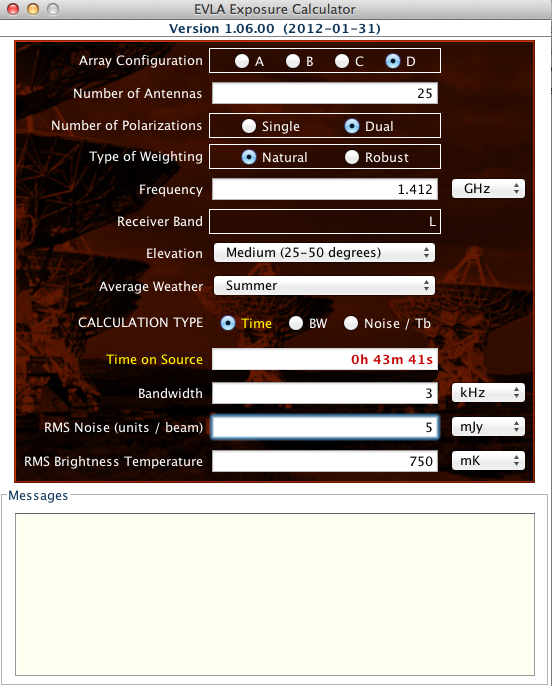
The sensitivity of spectral line data is best calculated with the VLA Exposure Calculator. This JAVA tool (see screenshot) allows one to enter sensitivity limits and provides the required time on source given a frequency, weather, weighting scheme, polarization products, and bandwidth of the observations. The Bandwidth should correspond to the frequency resolution that is required to perform the science. This may or may not be the width of individual spectral channels. Overheads need to be added according to our VLA frequently asked questions webpage. We refer to the low frequency guide and high frequency guide for further advice on how to set up the observations, depending on the receiver band to be used.
The WIDAR Correlator
Together with the wide, instantaneous receiver bandwidths, the WIDAR correlator at the VLA is very flexible and provides a number of setup options that are relevant for spectral line observing.
Basebands
Let's start with the basics: A signal from the telescope enters the WIDAR and along that path, it is passing analog filters that define the basebands. The basebands are actually baseband pairs to cover the L and R polarizations. They are the most fundamental spectral ranges delivered from the samplers and digitizers to the correlator. In the 8-bit mode, the samplers deliver two independably tuneable basebands (dubbed AC0 and BD0) with 1 GHz bandwidth each. Using the 3-bit samplers, there are 4 baseband pairs (A1C1, A2C2, B1D1, B2D2), each of them 2GHz wide. Each baseband pair can be set to a baseband sky frequency. Alternatively, the sky frequency can be calculated using the Doppler Setting tool in OPT.
When the signal enters WIDAR, the basebands pass through a number of digital filters, each 128MHz wide, the fixed 128MHz subbands.
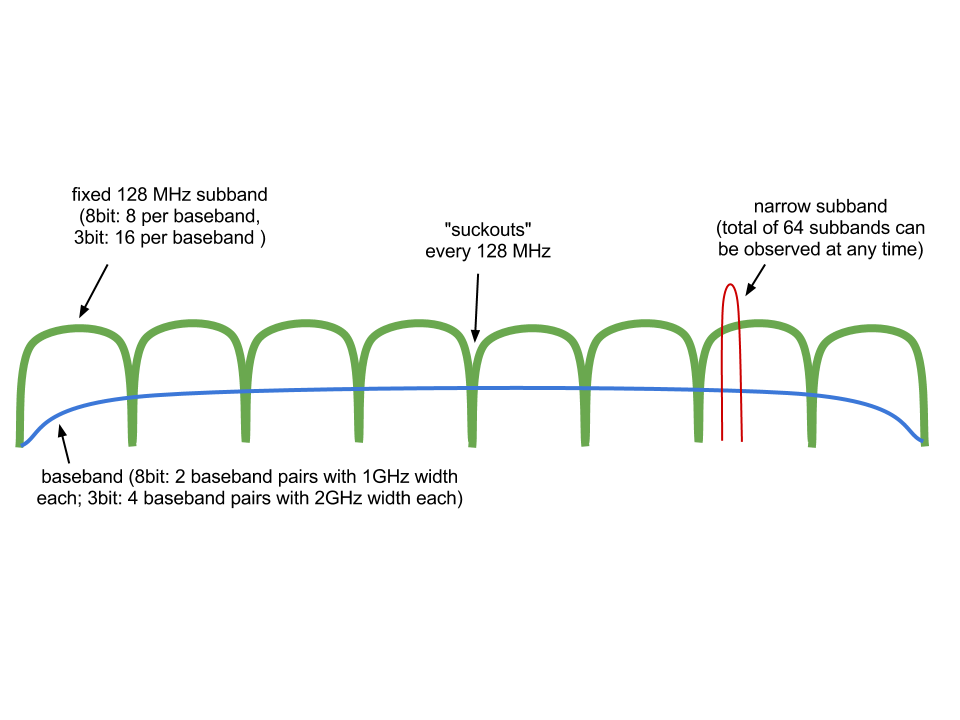
Fixed 128MHz Subbands and 128MHz "Suckouts"
After filtering through the basebands, the signal enters the correlator and is split into fixed, 128MHz wide subbands. They are placed adjacently to cover the full width of the basebands. As each fixed 128MHz subband has some filter shape with soft corners, the sensitivity of the VLA drops to about half its value between any two fixed 128MHz subbands. These frequency ranges are called "128 MHz Suckouts". There are a few options to account and interpolate over the suckouts:
- Easiest method is to avoid them in your spectral setup. Try to set the baseband frequency in a way such that any interesting lines do not fall in the suckouts. We offer a spectral line setup tool that can be used to maximize the frequency separation between a number of spectral lines and the suckouts.
- Observe with two basebands shifted by 10-64MHz apart. This will ensure that at one of the baseband covers the suckouts of the other baseband with full sensitivity. An example is given in the figures to the right. To obtain more spectral channels, one can consider to using single polarizations on the basebands.
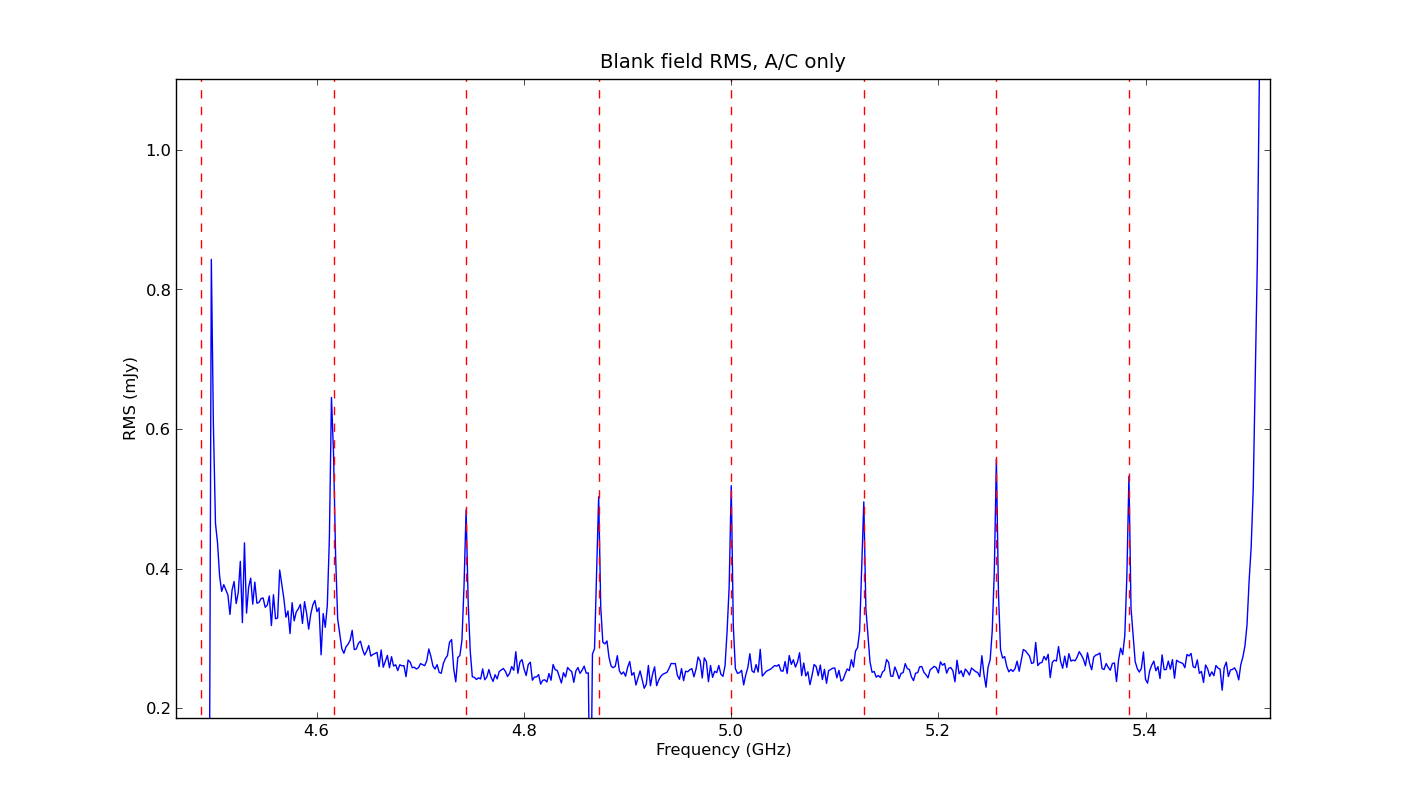
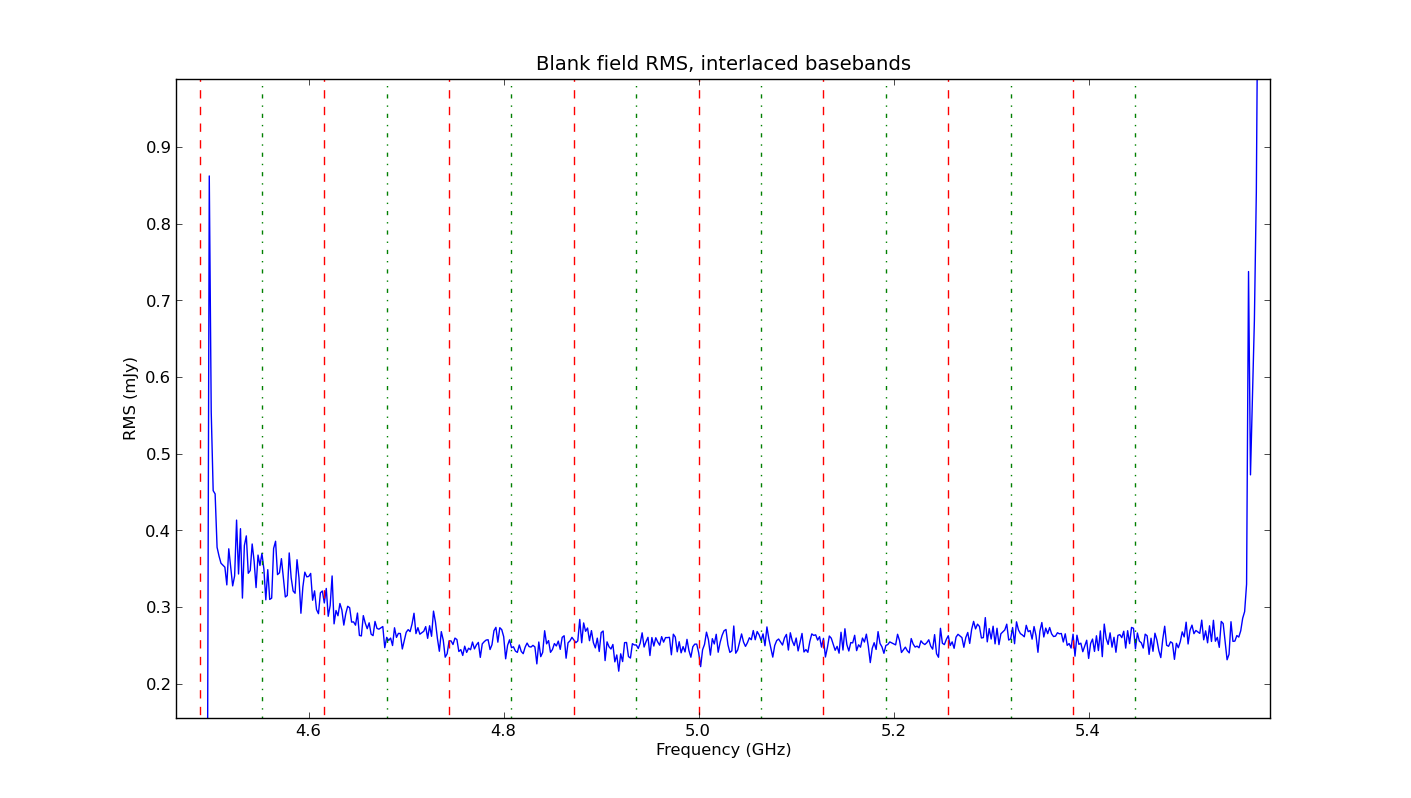
Narrow Subbands
For every baseband, there can be a maximum of 64 subbands (for the August 2012 deadline, we offer up to 16 subbands per baseband for normal observations). These subbands can be one of the fixed 128MHz wide subbands or more narrow, tunable subbands. Fundamentally, each narrow subband can be between 128 MHz (corresponding to a fixed subband) and 31.25 kHz wide and contains 64 channels when all four RR, LL, RL, LR polarization products are required (full polarization), 128 channels in dual polarization mode (RR & LL), and 256 channels for single, RR or LL polarization products. The two tables display the options for full and dual polarizations with the corresponding velocity widths and channelizations. Higher spectral resolution can be achieved with baseline board stacking and recirculation (August 2012: only shared risk) as described below.
- Full polarization
| Sub-band BW (MHz) | Number of channels/poln product | Channel width (kHz) | Channel width (km/s at 1 GHz) | Total velocity coverage per sub-band (km/s at 1 GHz) |
|---|---|---|---|---|
| 128 | 64 | 2000 | 600/ν(GHz) | 38,400/ν(GHz) |
| 64 | 64 | 1000 | 300 | 19,200 |
| 32 | 64 | 500 | 150 | 9,600 |
| 16 | 64 | 250 | 75 | 4,800 |
| 8 | 64 | 125 | 37.5 | 2,400 |
| 4 | 64 | 62.5 | 19 | 1,200 |
| 2 | 64 | 31.25 | 9.4 | 600 |
| 1 | 64 | 15.625 | 4.7 | 300 |
| 0.5 | 64 | 7.813 | 2.3 | 150 |
| 0.25 | 64 | 3.906 | 1.2 | 75 |
| 0.125 | 64 | 1.953 | 0.59 | 37.5 |
| 0.0625 | 64 | 0.977 | 0.29 | 18.75 |
| 0.03125 | 64 | 0.488 | 0.15 | 9.375 |
- Dual Polarization
| Sub-band BW (MHz) | Number of channels/poln product | Channel width (kHz) | Channel width (km/s at 1 GHz) | Total velocity coverage (km/s at 1 GHz) |
|---|---|---|---|---|
| 128 | 128 | 1000 | 300/ν(GHz) | 38,400/ν(GHz) |
| 64 | 128 | 500 | 150 | 19,200 |
| 32 | 128 | 250 | 75 | 9,600 |
| 16 | 128 | 125 | 37.5 | 4,800 |
| 8 | 128 | 62.5 | 19 | 2,400 |
| 4 | 128 | 31.25 | 9.4 | 1,200 |
| 2 | 128 | 15.625 | 4.7 | 600 |
| 1 | 128 | 7.813 | 2.3 | 300 |
| 0.5 | 128 | 3.906 | 1.2 | 150 |
| 0.25 | 128 | 1.953 | 0.59 | 75 |
| 0.125 | 128 | 0.977 | 0.29 | 37.5 |
| 0.0625 | 128 | 0.488 | 0.15 | 18.75 |
| 0.03125 | 128 | 0.244 | 0.073 | 9.375 |
WIDAR Tuning Restrictions
The baseband (pairs) cannot be entirely independently tuned. The following restrictions apply:
- 3-bit samplers can only be used in C-band or above, where the instantaneous frequency width of the receiver is larger than 2GHz.
- In Ka band, 3-bit samplers, only one baseband can be below 32GHz and that must be BD
- The 8-bit A1C1 baseband frequency can have a separation of max. 4GHz from the A2D2 baseband. B1D1 and B2D2 have the same restriction of 4GHz maximum separation
For the narrow subbands:
- Narrow subbands can not go across a 128MHz suckout frequency. Any narrow subband needs to be entirely within a 128MHz fixed subband.
Correlator Baselineboards
Correlator baselineboards (BlBs, also named "BL.BPS" in OPT) are independent units that can be used for separate subbands. WIDAR has 64 BlB pairs (for the polarizations) and thus supports a maximum of 64 subbands.
Baselineboard Stacking
If not all of the 64 subbands are used, the remaining BlBs can be used to obtain more channels per subband. This method is called "baselineboard stacking" and each additional BlB for a subband adds another 64 channels in full and 128 channels in dual polarization modes. In OPT's resource tool (RCT), this can be set via the BLB.BPS dropdown menu that is available for each subband. E.g. the full 2GHz bandwidth of the 8-bit samplers can be covered by 16 128MHz subbands, each with 128 channels dual polarization as in the table above. The 16 subbands, however, only require 16 BlBs and another 48 are available for baselineboard stacking. One can thus use 4 BlBs for each of the subbands, quadrupling the number of channels from 128 to 512, which reduces the channel widths from 1MHz to 0.25 MHz over the full 2 GHz frequency range. This method works for any subband bandwidth.
Baseline board stacking is also extremely useful as it allows the use of wider bandwidths for each subband while still maintaining a high number of channels. This minimizes the number of filter edges that are unavoidable for each subband.
Recirculation
Another way to obtain more spectral channels for a given subband is called "recirculation". Recirculation uses the fact that the correlator has more computing capability when the data is averaged in time. The basic correlator dump time is 1s. If this is doubled to 2s, WIDAR can produce twice as many channels as listed in the tables above. 4s would allow 4 times the number of channels. This setup, however, is only available in for shared risk observations.
Data Rate Limits
Baselineboard stacking, recirculation, and time resolution, however, can add up to an extremely high data rate in the correlator. The VLA currently supports data rates of up to 15MB/s for regular and higher data rates for shared risk observing. The OPT instrument configuration calculates data rates based on the spectral line setup and the limit of 65 MB/s should not be exceeded for any observational setup.
Planning and Setup of VLA Spectral Line Observations
For the August 1 deadline, the following capabilities are offered (more options are available for "shared risk" observing, see the VLA Observational Status Summary):
- up to 16 subband pairs per baseband pair
- independent tuning of all subbands
- independent subband bandwidth in the 31.5-128MHz range
- independent number of channels, up to 2048 channels for single polarization product, 1024 dual, 512 full polarization; maximum number of channels distributed across all subbands an polarization products cannot exceed 16384 channels
- Doppler setting
- The maximum data rate, however, cannot exceed 15MB/s
The Proposal Submission Tool (PST)
To observe all the restrictions listed above for the August 2012 deadline, the Proposal Submission Tool (PST) includes a spectral setup tool. The PST is accessible via my.nrao.edu. You may need to register at if you do not yet have an account.
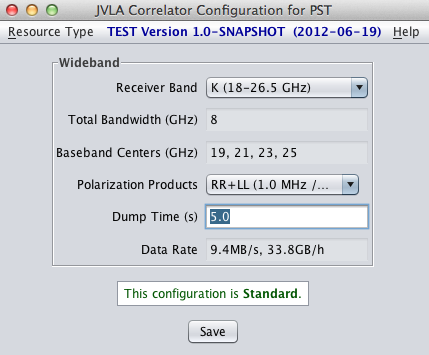
Wide-band mode (3-bit sampler, up to 8GHz bandwidth) can be used for spectral line observing as well. The channel width is fixed to a resolution of 2MHz and no narrow subbands can be chosen.
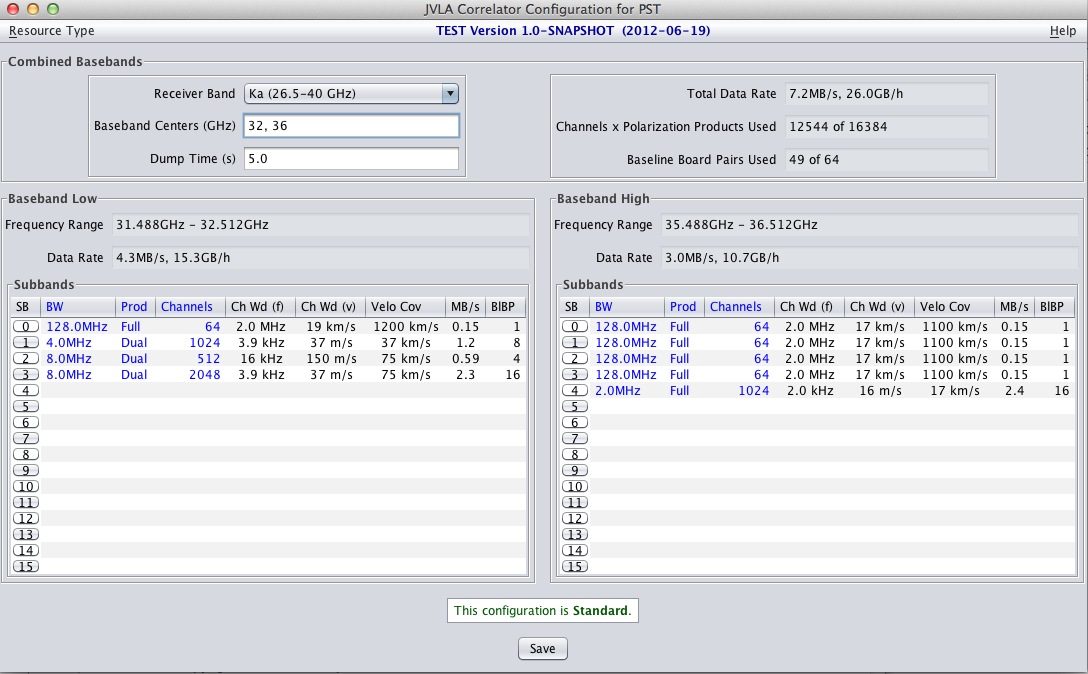
The 8-bit sampler data can be setup with the flexibility mentioned above. The figure shows an example where 9 subbands were chosen in Ka band, four in the first and 5 in the second baseband. The setup features different subband bandwidths, polarization products and baselineboard stacking (up to 16 for a couple of subbands). A total of 49 baseline boards are used for this configuration. A full description of the tool is provided here --- ??? link to Michael's manual.
Setting up a Spectral Observation using the Observation Preparation Tool (OPT)
The Observation Preparation Tool (OPT) is the web-based interface to create scheduling blocks (SBs) for the VLA. An SB is a block of time during which an observation is executed. A full project may constitute of several SBs. To access the OPT, go to my.nrao.edu and click on the Obs Prep tab, followed by Login to the Observation Preparation Tool. Please also read the OPT webpage that contains the latest information on the OPT as well as a comprehensive OPT manual.
Frequency Setup
For the data taken early 2013 (August 2012 deadline), we will provide a specific new OPT Instrument Configuration layout for the regular and shared risk observing modes. The description below is for the current OSRO and RSRO modes.
One of the most important parts of the setup is to chose the appropriate frequency setup for WIDAR. In the OPT, click on the Instrument Configuration tab. The most advanced setting is currently the RSRO setting (File -> Create New -> RSRO Configuration). This opens a page for the frequency setup as shown in the figures. Note that you may only hve access to the OSRO configuration utility, depending on your history of VLA observations. The OSRO setup is a more restricted version of the RSRO setup.
- Enter a name and select the receiver in the top panel. This will adjust the available frequency range described below the drop down menu. The 1dB and 3dB ranges describe the roll-off behavior of the receiver sensitivity at the receiver band edges. If the frequency to be observed is close to the edge frequency of a receiver, one may check if the next higher or lower frequency receiver is more suitable.
- Baseband Tuning: Select the position of the basebands. For the 8bit samplers, the central frequencies for 2 basebands are to be provided, each with a width of 1GHz. The center frequencies will go into the A0C0 box for frequency 1 and into the B0D0 box for frequency 2. For 3bit samplers, 4 basebands are available, each 2 GHz wide. Here, the center frequencies need to placed into the A1C1, A2C2, B1D1, and B2D2 boxes. A1C1 and A2C2 cannot be more than 4GHz apart, and the same restrictions apply to B1D1 and B2D2. Note that additional frequency restrictions may apply and the OPT/ICT will issue a clear warning or error message for those cases. The graphical panel above the input boxes shows the position of the two or four basebands. They are displayed as pairs to accommodate the R and L polarization inputs that may later be converted into single, dual, or full polarization products.
- Integration Time: this defines how data is dumped from the correlator backend into data files. A larger integration time will reduce the data volume. In addition, larger values can be chosen to take advantage of recirculation (only shared risk). On the other hand, time smearing effects, RFI excision, or time resolution may demand smaller integration times. It is important though, to not exceed the maximum data rate of 75 MB/s (15MB/s for regular observing) and the integration time parameter is a good way to stay below this threshold for observations that demand large number of spectral channels.
- The total data rates are displayed in the Configuration Summary. The same panel also shows the number of baseline boards that are used in the setup. Remember that a maximum of 64 baseline boards are available. During commissioning, it is advisable to not use all baseline boards, as some of them may undergo maintenance. Also make sure to stay within the data rate restriction limits.

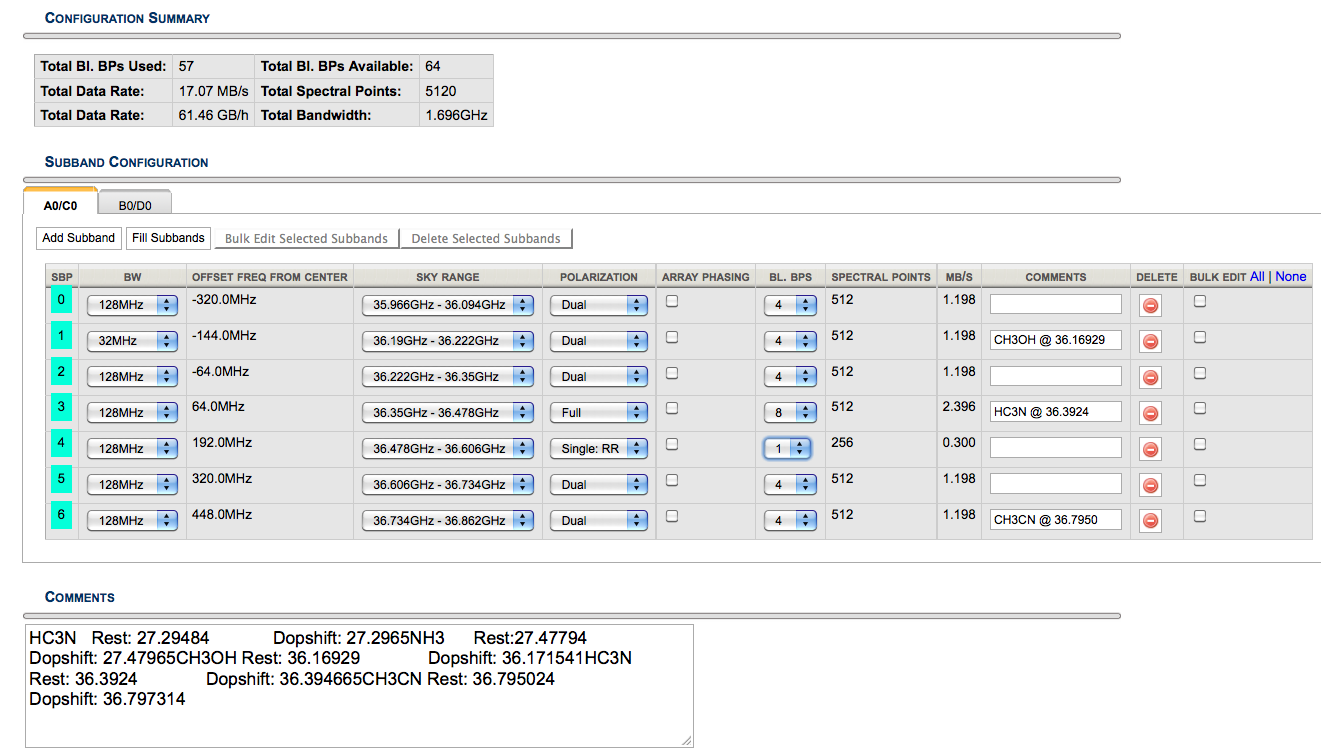
- Subband Setup: Depending on the baseband setup, the Subband Configuration panel sports tabs for each baseband. Under each tab one can now select the individual subbands. Up to 64 subbands are available (16 for regular observing): click Add subband to create a subband setting and select the frequency range from the "Sky Range" drop-down menu. The Offset Freq from Center shows the placement of the subband with respect to the baseband center. For small bandwidths, the drop-down menu is not available as there are too many choices and the placement needs to be entered by hand in the Offset Freq from Center box. In teh current OSRO/RSRO interface, the subbands are not independently tuneable yet (but this feature will be available for the Ausgust 2012 deadline) and the subbands will snap on a frequency grid defined by the subband bandwidth. Now select the number of polarization products and the number of channels will be displayed in the Spectral Points box. The comments box can be used to describe the setup, e.g. by entering the transitions that should afll in that subband. Those entries are not used anywhere outside OPT (??? rest frequencies for OSRO ???). The delete button removes the subband if is is no longer required, and Bulk Edit is used for bulk editing of many subbands (see the OPT guide on this feature). Note: if you chose subbands with different bandwidths during OSRO/RSRO, contact NRAO staff as the script currently need manual editing after OPT submission
- If not all subbands are used, one can use the remaining baseline boards to obtain a higher spectral resolution for those in the Subband Configuration panel. Select a higher number in the BL.BPS drop-down panel for baselineboard stacking. During commissioning, we recommend to use 2,4,8, etc. BlBs here but in principle any of the options in the drop down menu should work.
- Recirculation: only shared risk
Doppler Setting
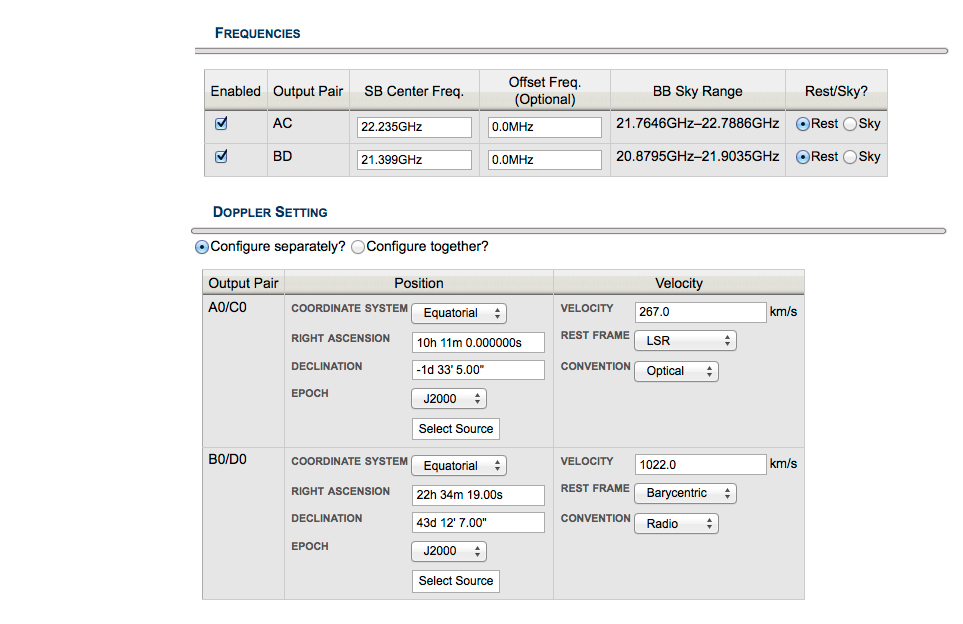
Doppler setting will calculate the sky frequency of your observation, based on the time of the observation, the velocity, position and rest frequency of a source and line. Contradictory to to Doppler tracking, Doppler setting calculates this once for each baseband at the start of the observation (execution of the SB) and the sky frequency will stay fixed for the entire run of the SB. Every subsequent run of the SB will perform a recalculation of the sky frequency. Doppler setting is currently only supported in OSRO mode (and will be available for the August 2012 deadline), RSRO observers need to calculate their own sky frequency (which is usually not too difficult given that the movement of the earth shifts the line by 30 km/s over a year, 0.5 km/s over a day - a velocity range that can under almost any circumstances be accommodated for by the wide bandwidths of WIDAR).
To use Doppler Setting, first select Rest in the baseband frequency setup section of the OPT/Instrument Configuration Tool. All velocities will then be calculated against the center baseband frequency which may or may not be the rest frequency of your spectral line. Supply the reference position (a source from a catalog can be chosen, typically this will be your target source) and the velocity with their frames in the Doppler Setting section in the OPT/ICT. Doppler Setting can only be applied for each baseband and all subbands will shift by the same frequency amount, offset by the the subband tunings.
Bandpass Setup
All observations with the VLA - even those with the goal of observing continuum - require bandpass calibration. A bandpass calibrator should be bright enough, or observed long enough, so that the bandpass calibration does not significantly contribute to the noise in the image. This implies that, for a bandpass calibrator with flux density Scal observed for a time tcal and a science target with flux density Sobj observed for a time tobj, should be greater than . How many times greater will be determined by one's science goals and the practicalities of the observations, but should be greater by at least a factor of two. For extremely narrow channels or very weak bandpass calibrators, those typical flux requirements can lead to extremely large integration times. As an alternative one may then chose to interpolate in frequency, or to fit a polynomial across all channels in post-processing (bandtype=BPOLY in CASA's bandpass task.
The bandpass calibrator should be a point source or have a well-known model. At low frequencies, the absolute flux density calibrators (3C48, 3C147, or 3C286) are quite strong and in many cases can double as bandpass calibrators. At high frequencies, however, these sources have only moderate flux densities of ~0.5-3 Jy, translating into a potentially noisy bandpass solution. A different, stronger bandpass calibrator should then be observed.
The stability of bandpasses as a function of time is of concern for high-dynamic-range spectral work. We have found that most antennas show bandpasses that are stable to a few (~2-4) parts in a thousand over a period of several (~4-8) hours.
Dramatic jumps in the bandpass structure (of order a few parts in a hundred) can occur at attenuator changes. The observer can track down such attenuator changes in their data using the switched power information; the On - Off power ('PDIF' in AIPS) will show a clear discontinuity. For this reason, it behooves the spectral line observer to observe a bandpass calibrator at least twice during their observations. Multiple observations will provide a check that all is well on most antennas and a mechanism for identifying any "problem" antennas. However, we do not expect that interpolating in time between consecutive bandpass solutions will bear much fruit for the observer. The low-level variations observed on some antennas tend to not be smooth functions of time and will likely not be corrected with interpolation.
If there is only one observation of the bandpass calibrator, the observer should be careful to minimize the number of shadowed antennas, as an antenna without a bandpass determined for it will essentially be flagged in the data for the rest of the observation.
We have shown that one can transfer the bandpass from a wide subband onto a narrow subband if the wide bandpass frequency range covers that narrow one. This may be good to the per cent level. But we advise to use that option only when absolutely necessary.
A complication can occur when the frequency range of the bandpass is contaminated by other spectral features such as rfi lines or Galactic HI in absorption or emission. There are two basic options to accommodate that situation:
- if the feature is narrow, one can simply observe as usual. In post-processing, the narrow feature can be flagged and the frequency gap interpolated by values of nearby channels, or by fitting a polynomial across the bandpass.
- for wider contaminating lines, an option is to observe the bandpass at slightly offset frequencies and transfer the bandpass to the target frequency. If a common solution is obtained from two, symmetric offsets at higher and lower frequencies, the solution can be improved. Depending on the choice of offsets and also on the position in the receiver frequency range the error can vary. For 4 MHz offsets close to the HI rest frequency of 1.42GHz, the error is in the per cent range. A guide for CASA is described on this on this CASAguides wiki.
Phase/Complex Gain Calibration
The complex gain (phase/gain) calibration is the same for a spectral line observation as for any other observation. Ideally one should stick with the correlator setup for the target and the complex gain calibrator. For weak calibrators, however, it is possible to use wider bandwidths for the phase calibrator and then transfer the phases to the source. However, there will be a phase offset between them. The phase offset between the narrow and wide subbands can be determined by observing a strong source (e.g. the bandpass calibrator) and applied in post-processing from the complex gain calibrator to the target sources. A similar method can be used if the complex gain calibrator is observed at a slightly different frequency, e.g. to avoid a contaminating line feature such as Galactic HI.
Continuum Subtraction
The continuum of an observation can be either subtracted in the uv plane (uvcontsub in CASA) or in the image domain (imcontsub). In most cases, the uv-domain is preferred but for high dynamic range imaging, or imaging close or beyond the edge of the FWHM of the primary beam, it may be better to subtract the continuum using line-free channels in the image cube, or to Fourier transform the com=ntinuum image and subtract these data from the visibilities (uvsub). All methods have in common that the continuum can only be determined accurately when enough line-free channels are observed that are necessary to derive a good model for the continuum. If the continuum sources exhibit significant spectral slope or even curvature, it is advisable to go to even larger bandwidth covering more line-free frequency space and to sample the continuum with many channels to ensure that a reasonable higher-order fit can be derived and subtracted from the line+continuum data.
High Dynamic Range Imaging
For very strong and narrow spectral features (typically thousands of Jy strong sources), one may see the Gibbs phenomenon (ringing) and Hanning smoothing may need to be applied (see above). This needs to be done in post-processing. The effect, however, can be reduced by using a higher spectral resolution such that the ringing effects beat against each other, effectively reduce the zig-zag pattern that appears on alternating, neighboring channels when the peak is within a single spectral channel.













